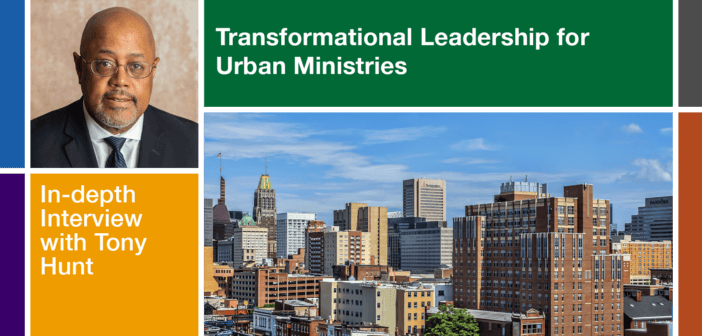How can church leaders address the challenges of urban ministry in a transformative way? Doug Powe speaks with Tony Hunt, a pastor and scholar, about reading a community well, identifying assets, and the importance of understanding your ministry context. Learn how to develop the transformative qualities of effective leadership.
Listen to this interview, watch the interview video on YouTube, or continue reading.
Doug Powe: Welcome to Leading Ideas Talks, a podcast featuring thought leaders and innovative practitioners. I’m Douglas Powe, the director of the Lewis Center, and your host for this talk. Joining me is the Reverend Doctor Anthony Hunt, Tony, who is a pastor and scholar. We’re focusing on his book Hope for the City: Transformational Leadership Development for Urban Ministries. Tony, I’m excited to have you with us today to talk about your book and urban ministry leadership.
Tony Hunt: Thank you for having me, Doug, I look forward to the conversation.
Doug Powe: Tony, how would you define the term urban? I have learned that people mean different things when they use the word urban. So, if you could define for us, at least in your opinion, how do you think about the term urban?
Tony Hunt: There are multiple ways to think about urban, what it is to be urban, and urban in the process of urbanization. Scholars like David Claerbaut and Ronald Peters give us an indication of what it looks like, but it’s more characterizations than a singular definition. The definitions are embedded in the characterizations. Most of those who study urban studies and urban ministry would say that urban is not confined to a municipality, space, or physical boundaries. That’s a part of it, but urban itself is characterized by the type of density in community. There are people, the type of movement of people in the community, the diversity of a particular area, traffic flow, business, and economics. You can look back to early civilization and see how those communities functioned as economic and political entities in themselves. Urban can be a very large area, or it can be an area that’s defined as a city, but a city is not the sole characteristic that defines urban. Urban includes space and how people relate with each other across the various forms of density. These characteristics express that urban is more than a physical, political, or municipal boundary.
Doug Powe: If I’m hearing you correctly, part of the challenge with the term urban is that we often define it simply as “city,” but it’s more complex and complicated in terms of what should count as urban. Depending on where you may be located, what may be urban in one place may not be urban in another place.
Tony Hunt: In my experience working in cities like Baltimore, Washington, and other cities across the country, the challenge is that many persons who are urban, or in urban contexts, don’t want to be defined as urban because it takes on a negative connotation or is seen as something that is “less than” more suburban communities. There are urban types: there’s traffic, there’s diversity in community, there’s density of population, and so some inner suburban areas are more urban than they are suburban. That gets to really defining urban as this sense of hope, this sense of possibility, as well as some of the real challenges that we face when any large group of people get together who are diverse.
Doug Powe: Your book, again, is Hope for the City: Transformational Leadership, Development for Urban Ministries. Many urban areas are becoming more diverse today. How is this a wonderful thing and a challenge for congregations in those communities?
Tony Hunt: [It’s a] challenge for congregations, nonprofits, and anyone who is working in urban communities. Another part of my work is building community through the “beloved community.” One of the challenges is really defining a community that has the complexity and dynamics of diversity. You have age diversity, racial ethnic diversity, economic diversity, gender diversity, identity diversity, and national diversity in any given zip code.
With all these types of diversities converging it can be challenging to identify the mission and purpose of a community. The community is defined by the people who are in it, and they bring meaning, hope, and blessing out of that. The challenges are in the diversity itself because it’s not a monolithic type of diversity. It’s multiple diversities within those categories. For example, all black people or African American people do not think the same, do not have the same experiences, do not believe the same. How do we work with that and see that as a gift?
Doug Powe: A leader in an urban community will wonder “how do we connect with a certain group of people?” Be it economically, racially, ethnically, we want to connect with middle class individuals so we can program in that way. But in an urban area where you have so much diversity, you’ve got to think more creatively. You can’t just simply say, “I’m going to just do this type of program.” I’ve got to maybe think more creatively about how I’m going to do the program.
Tony Hunt: Exactly. There’s no cookie cutter to leading in any context. As it relates to urban contexts, there’s certainly not a cookie cutter. In the book I talk about the leadership practices of reading a community well, of understanding who’s in the community, and of listening well. Our good friend and colleague Joe Daniels calls walking a community “walking like Nehemiah.” I call it exegeting the culture and the community. That’s not a term that’s original to me. One of the lessons I practice with the leadership team at the church I pastor, Epworth Chapel, and with the students from Wesley Seminary and other places, is to walk your catchment area. Walk around and see what you see. Do you see grass? Do you see broken windows? Who are the mayors in your community? Who has influence? Asset-based community analysis and getting to know the community informs leadership. It’s contextual leadership. And again, there’s no cookie cutter because in a city like Baltimore you have 26 different defined communities, and then you have even more communities within those.
The principles could apply, but when we walk, we see something different, or we may walk differently. Contextually, the work of Hope for the City: Transformational Leadership in Urban Ministries, is evidence-based work that’s tied to standard leadership practices and what leadership theorists are doing, but contextualizing leadership to apply to specific contexts. So, what is in the catchment zone of a zip code? Who’s there? What people are there? What process is there? What does the place look like? What’s not there? Is there a grocery store in the community? I ask, “Is there a Starbucks in the community?” because that says a lot about what people are thinking about that community and what might be coming. What are indicators of hope for a particular community?
Doug Powe: You often lead sort of a pilgrimage or immersions in the communities, and you’ve talked about working with students doing that sort of work in Baltimore. You have laid out some of the ways you help them to exegete the community as you’re walking through. What have you overheard the students say regarding some of the assumptions they were making before you helped them to see with new eyes? What are some of the assumptions people who don’t live in urban communities make so that when they exegete the community, they’re surprised by what they discover?
Tony Hunt: Some of the ways that we were educated and informed about cities, share our reflections particularly for those who might not have ever lived in a city. When we do the immersions in Baltimore, or even in cities like Birmingham, Montgomery, and Selma, Alabama, Atlanta, I see the same thing in places like Minneapolis, parts of Chicago, and Milwaukee.
Doug Powe: You talk about King in the book and you’re a King scholar. King fared better in southern urban areas than he did when he went north to Chicago. King in many ways was a quick exegete; he understood the importance of context and everything. But what are the lessons that we can take away from someone like King, who was so successful in southern urban areas but really struggled when he went up north?
Tony Hunt: The lesson for all leaders today is that all leadership is contextual. Montgomery — whatever the success is there in the Civil Rights movement — the tactics, the contexts of people were different than Chicago. Obviously, Chicago, Los Angeles, Detroit, other places where King went, they were much more complex in many ways because they were larger.
I agree with your observation. The work of civil rights was largely urban work. It was in cities like Atlanta and Albany, Georgia, smaller and somewhat differently complex cities. What I want people to learn from Dr. King’s lesson in cities like Chicago — that did not go well — is that you must lead in different forms of nuance in a place like Chicago. Baltimore and D.C. are cojoined by a parkway, but they are very different cities. I’m a son of an inner-city, Washington, D.C., an urban area, but it is not inner-city Baltimore, and vice versa. If I were leading in Southeast Washington and Anacostia and then I went to the area where Wesley Seminary is, those are different contexts even in one city. Leadership is always contextual. That’s the point of a lot of my work — to really test our presumptions and then enter leadership always keeping our context in mind. Therefore, we must be adaptive as leaders as we seek to transform community.
Doug Powe: How do you help individuals develop that adaptive leadership that is needed to do well if they’re going to lead ministries or pastor anywhere, but particularly pastor in an urban area? You adapted from D.C. to Baltimore. How do you help individuals develop adaptive leadership? You’ve talked about exegeting, but what other things are characteristics that we need to work on? It’s not that any of us have these things perfectly, but we need to think about and work on these things as we think about our leadership.
Tony Hunt: Leadership is a practice. There are theories that underlie practice, and I believe that those practices are transcendent. I’ve worked in all types of settings — governmental settings, nonprofit settings, consulting settings, military, church, academic settings — and observed leadership and been in leadership in those settings as well. In church leadership, it is important to understand the context and the culture. Dr. Lovett Weems talks about the church itself being a culture. Every church is a micro culture. It’s a culture within a metaculture, community, jurisdiction, and so on with politics and everything.
Transformative qualities really begin from within. We want to test our identity as leaders. Are we being transformed within? Paul talked about being transformed by the renewing of our minds first and therefore we go forward in terms of transformative process. Practicing good qualities of observing, listening, team building, understanding where assets are and how to galvanize and organize those assets, are transformative processes that I believe any leader could benefit from in a community. It takes a lot of time, coaching, and coming alongside leaders. One of the things I’ve discovered with newer leaders is that we can learn the theory, but the practice is really a matter of trial and error. Leaders need to learn on the ground, test presumptions about their leadership, about who they are, and then develop the skills to build teams, to organize people, to organize resources, and then articulate the vision. It’s multifarious. In urban areas, it’s a bit more complex because many urban communities are a challenge, or at least sense a challenge of a lack of resources.
So, I believe the transformational shift is one from being scarcity focused to being really focused on: What is abundance? What does flourishing and thriving look like? And what does adeptness look like for our communities?”
Doug Powe: My next question is around resources because I do think that many people try to avoid urban ministry because of the fear of the lack of resources. I appreciate you talking about how transformative leaders think about it differently. So, what are some ways to think about resources? When we think resources, we automatically think money, but resources are more than money. So how do we help people think outside of the box in terms of what it means in terms of resources?
Tony Hunt: It’s simple in a way because every community has assets. So, the first thing I would tell myself if I were going into a community today, and what we help others practice, is to really look at a community.
I’ve spoken to numerous persons who had a sense when they were appointed to an urban area that it was a less desirable kind of appointment. That’s the perception: what did I do wrong to be appointed to Baltimore, and not to Baltimore County, but Baltimore City?
So, asset-based analysis. I work from the presumption that every community has assets. Every community I’ve ever served in has assets, people. The first thing is to qualify the assets. So, who’s in our communities in terms of people? In terms of institutions, is there a school, college, university, because that’s an asset. Shopping venues, vacant buildings, highways, banks, are assets. So, we have categories of assets that we want. By default, I look at a community and say: “these are assets and therefore they are opportunities to really galvanize and organize around ministry or around work.” I believe that nothing’s wasted, so everything in a catchment zone, zip code, or impact zone is a potential opportunity. A boarded-up building is a potential opportunity.
Doug Powe: That’s helpful. Tony, I really have enjoyed the conversation. You have used in our time the word hope often. So, what is your hope for transformational leadership?
Tony Hunt: What I’ve learned is that the differentiating factor in thriving organizations is thriving leadership. My hope is through my work, and having been trained first as an economist, then getting an MBA, then figuring out that management and leadership are not always the same, is that working and helping to resource in ways that we can. That the processes of transformative leadership are based on the evidence, are the factors why some urban churches and pastors thrive when others may struggle. The differentiating factors are the qualities of transformative leadership somewhere. How do we equip, how do we tool pastors to serve in these contexts? That’s my hope — that we don’t give up on the opportunity in urban contexts, but that we work with leaders to help. That’s one aspect. Obviously, there are other assets and things that need to happen, but leadership really does matter. Transformative, transformational leadership, transforming leaders matters in our community.
Doug Powe: Tony, thank you. This has been a great conversation. I appreciate your being with us and sharing from your book Hope for the City.
Tony Hunt: Well, thank you for the opportunity, take care.
Related Resources
- Transformational Leadership for Urban Ministries featuring Tony Hunt | Leading Ideas podcast episode | Podcast video
- Ten Ways to Build the Beloved Community by Tony Hunt
- Your Community is Your Congregation by Joe Daniels
- 7 Steps to Reengage Your Community by Candace M. Lewis and Rodney Smothers
- 10 Leadership Lessons from Nehemiah by Lovett H. Weems Jr.







